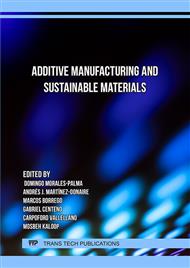[1]
M. A. Matos, A. M. A. C. Rocha, and A. I. Pereira, Improving additive manufacturing performance by build orientation optimization, Int. J. Adv. Manuf. Tech., 107, 5–6 (2020).
DOI: 10.1007/s00170-020-04942-6
Google Scholar
[2]
M. Fera, F. Fruggiero, A. Lambiase, and R. Macchiaroli, State of the art of additive manufacturing: Review for tolerances, mechanical resistance and production costs, Cogent Eng, 3, 1 (2016).
DOI: 10.1080/23311916.2016.1261503
Google Scholar
[3]
S. A. M. Tofail, E. P. Koumoulos, A. Bandyopadhyay, S. Bose, L. O'Donoghue, and C. Charitidis, Additive manufacturing: scientific and technological challenges, market uptake and opportunities, Materials Today, 21, 1 (2018).
DOI: 10.1016/j.mattod.2017.07.001
Google Scholar
[4]
M. E. H. Korner, M. P. Lambán, J. A. Albajez, J. Santolaria, L. D. C. N. Corrales, and J. Royo, Systematic literature review: Integration of additive manufacturing and industry 4.0, Metals, 10, 8 (2020).
DOI: 10.3390/met10081061
Google Scholar
[5]
A. du Plessis and S. Beretta, Killer notches: The effect of as-built surface roughness on fatigue failure in AlSi10Mg produced by laser powder bed fusion, Addit. Manuf., 35 (2020).
DOI: 10.1016/j.addma.2020.101424
Google Scholar
[6]
T. D. Szucs and D. Brabazon, Analysis of the effects of 3DP parameters on part feature dimensional accuracy, in 18th Solid Freeform Fabrication Symposium, SFF (2007).
Google Scholar
[7]
Y. Kok et al., Anisotropy and heterogeneity of microstructure and mechanical properties in metal additive manufacturing: A critical review, Mater. Des., 139 (2018).
Google Scholar
[8]
E. Yasa, O. Poyraz, E. U. Solakoglu, G. Akbulut, and S. Oren, A Study on the Stair Stepping Effect in Direct Metal Laser Sintering of a Nickel-based Superalloy, Procedia CIRP (2016).
DOI: 10.1016/j.procir.2016.02.068
Google Scholar
[9]
N. Guo and M. C. Leu, "Additive manufacturing: Technology, applications and research needs," Frontiers of Mechanical Engineering, 8, 3 (2013).
Google Scholar
[10]
P. Delfs, M. T̈ows, and H. J. Schmid, "Optimized build orientation of additive manufactured parts for improved surface quality and build time," Addit. Manuf., 12 (2016).
DOI: 10.1016/j.addma.2016.06.003
Google Scholar
[11]
L. di Angelo, P. di Stefano, and E. Guardiani, "Search for the optimal build direction in additive manufacturing technologies: A review," J. Manuf. and Mater. Proc., 4 (2020).
DOI: 10.3390/jmmp4030071
Google Scholar
[12]
Formlabs, The 2022 3D Printing Applications Report, (2022).
Google Scholar
[13]
A. Jaisingh Sheoran and H. Kumar, Fused Deposition modeling process parameters optimization and effect on mechanical properties and part quality: Review and reflection on present research, Materials Today: Proceedings (2020).
DOI: 10.1016/j.matpr.2019.11.296
Google Scholar
[14]
A. Dey and N. Yodo, "A systematic survey of FDM process parameter optimization and their influence on part characteristics," J. Manuf. and Mater. Proc., vol. 3, no. 3. 2019.
DOI: 10.3390/jmmp3030064
Google Scholar
[15]
E. García, P. J. Núñez, J. M. Chacón, M. A. Caminero, and S. Kamarthi, Comparative study of geometric properties of unreinforced PLA and PLA-Graphene composite materials applied to additive manufacturing using FFF technology, Polym. Test, 91 (2020).
DOI: 10.1016/j.polymertesting.2020.106860
Google Scholar
[16]
E. García Plaza, P. J. Núñez López, M. Á. Caminero Torija, and J. M. Chacón Muñoz, Analysis of PLA geometric properties processed by FFF additive manufacturing: Effects of process parameters and plate-extruder precision motion, Polymers (Basel), 11, 10 (2019).
DOI: 10.3390/polym11101581
Google Scholar
[17]
C. C. Wang, T. W. Lin, and S. S. Hu, "Optimizing the rapid prototyping process by integrating the Taguchi method with the Gray relational analysis," Rapid. Prototyp. J., 13, 5 (2007).
DOI: 10.1108/13552540710824814
Google Scholar
[18]
A. K. Sood, R. K. Ohdar, and S. S. Mahapatra, Improving dimensional accuracy of Fused Deposition Modelling processed part using grey Taguchi method, Mater. Des., 30, 10 (2009).
DOI: 10.1016/j.matdes.2009.04.030
Google Scholar
[19]
V. B. Nidagundi, R. Keshavamurthy, and C. P. S. Prakash, Studies on Parametric Optimization for Fused Deposition Modelling Process, Materials Today: Proceedings (2015).
DOI: 10.1016/j.matpr.2015.07.097
Google Scholar
[20]
A. Alafaghani, A. Qattawi, B. Alrawi, and A. Guzman, Experimental Optimization of Fused Deposition Modelling Processing Parameters: A Design-for-Manufacturing Approach, Procedia Manuf. (2017).
DOI: 10.1016/j.promfg.2017.07.079
Google Scholar
[21]
B. Vasudevarao, D. P. Natarajan, and M. Henderson, Sensitivity of Rp Surface Finish To Process, Solid freeform fabrication proceedings (2000).
Google Scholar
[22]
W. de O. S. Soares, R. S. Peruchi, R. A. V. Silva, and P. Rotella Junior, Gage R&R studies in measurement system analysis: A systematic literature review, Qual. Eng, 34, 3 (2022).
DOI: 10.1080/08982112.2022.2069505
Google Scholar
[23]
J. R. Figueira, V. Mousseau, and B. Roy, ELECTRE methods, International Series in Operations Research and Management Science, 233 (2016).
Google Scholar



